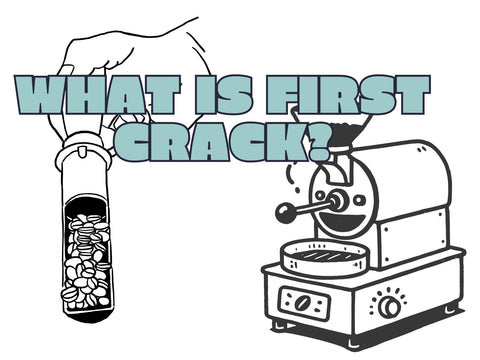Have you ever tried a peaberry coffee? If not, you're not alone because peaberry beans are relatively rare in the coffee world. They generally also have a higher price tag. You've come to the right place if you're curious about peaberry coffees.
This article will introduce you to what peaberry coffee beans are, how they are harvested, how to roast them, and much more. As peaberry coffee can be found in many coffee-producing countries worldwide, this article will look at the most popular countries for this coffee and what peaberry coffees taste like.
Anatomy of a Peaberry Coffee Cherry
Typically, coffee cherries contain two seeds. These are the regular coffee beans you can see in thousands of photos online. The peaberry coffee cherry is different: Only one rounded seed with a crack on one side develops inside the coffee cherry, hence the name “pea”berry.
Apart from just having one seed inside, the anatomy of the peaberry coffee cherry is the same as that of a normal coffee cherry. The seed is covered in a sticky mucilage, surrounded by the cherry fruit’s pulp and skin. A peaberry coffee bean is typically smaller and rounder than regular coffee beans.
Specific Regions Of Peaberry Coffee
Peaberry coffees aren’t limited to just Tanzania, even though that’s the most famous peaberry coffee country. Countries like Kenya, Rwanda, Costa Rica, Papua New Guinea, Hawaii in the USA, Brazil, Ethiopia, and Indonesia (Sumatra in particular) all produce a quantity of peaberry coffee, but let’s have a look at the four most popular regions for peaberry coffee.
Tanzanian peaberry coffee
Tanzanian peaberry coffee is particularly famous. This isn’t only because of how well these special coffee beans have been marketed. It’s also because Tanzanian peaberry beans, often grown on the slopes of Mount Kilimanjaro and in the Arusha region, are really that good. Tanzanian peaberry coffee has a bright acidity, a medium to full body, and fruity notes.
Jamaican blue mountain peaberry coffee
Jamaican Blue Mountain coffee is grown in the Blue Mountains of Jamaica. The peaberry coffees from this region are popular because of their exceptionally well-balanced flavor profile with mild fruitiness, floral tones, nuttiness, and a hint of spice. Authentic Jamaican Blue Mountain Peaberry coffee is labeled and certified by the Coffee Industry Board of Jamaica, so check the label.
Costa Rica peaberry coffee
Some regions in Costa Rica produce peaberry coffee. It is known for its moderate to high acidity and clean, crisp flavors. These coffees often include notes of caramel and honey. Costa Rican peaberry coffee has a medium body. Some Costa Rican Peaberry coffees have specialty coffee certifications, like Rainforest Alliance or Fair Trade.
Kona Coffee (Hawaii Peaberries)
Hawaii grows peaberry coffee beans on the slopes of Mauna Loa in the Kona district of Hawaii's Big Island. Kona coffee is often described as smooth, with a mild acidity. Kona coffee tends to have a medium body and a flavor profile that includes notes of nuttiness, chocolate, and mild fruity undertones.
Peaberry Coffee Harvest
Peaberry coffee cherries, which are a natural mutation, and normal coffee cherries grow on the same plant, so they are harvested at the same time. One of the reasons why peaberry coffee beans are more expensive is that the harvest and sorting process involves several extra steps to separate peaberry coffee beans from regular beans. Anywhere from 5 to 15% of all coffee beans are peaberry beans.
Not all coffee farmers sort their coffee beans to make special bags just with peaberry coffee beans. After all, the sorting process adds a hefty chunk of extra costs for manual labor or specialized machinery. Not all farmers can afford this, even though they can charge more for a bag of peaberry coffee. The absence of sorting on many coffee farms means you can often find peaberries in a bag of normal coffee.
After the harvest, coffee beans are processed as usual. The sorting happens after harvesting and processing. Farms either use mechanical or manual sorting. Some coffee mills have specialized machinery that can reliably filter peaberries from the whole harvest. Manual sorting is labor-intensive and is mainly used for premium peaberry coffees. While manual sorting is more reliable and accurate than machine sorting, it takes longer.
Roasting Process and Taste
Flavor Profile
-
Tanzanian Peaberry Coffee: Bright acidity, medium body, floral aromas, fruity and citrusy notes, often with hints of orange, lemon, or berry.
-
Kenyan Peaberry Coffee: Bright acidity, medium to full body, complex flavor profile with wine-like characteristics, notes of black currant and blackberry.
-
Costa Rican Peaberry Coffee: Balanced acidity, medium body, sweet and mild flavor with notes of caramel and honey, nutty undertones.
-
Papua New Guinea Peaberry Coffee: Moderate acidity, medium to full body, earthy and herbal notes with spicy and smoky undertones.
-
Hawaiian Kona Peaberry Coffee: Low acidity, medium body, nutty, and chocolatey notes with mild fruity undertones.
-
Jamaican Blue Mountain Peaberry Coffee: Low to moderate acidity, medium body, notes of nuttiness, and mild fruitiness with some spicy undertones.
How to Roast Peaberries
Roasting peaberry coffee beans slightly differs from roasting ordinary beans as roasters need to consider the beans' round shape. The important thing here is to realize that there's no one-size-fits-all approach. How you roast peaberries depends on their origin, how the beans were processed, and what flavors you want to highlight.
For example, Kona peaberries are often roasted to a medium roast level to highlight their mild and smooth flavors. In contrast, Costa Rican peaberries are typically roasted to a light roast or medium roast to bring out their bright acidity and nuanced flavor profile. Peaberry beans may require a slightly shorter roasting time (compared to regular beans) because they are smaller and have a higher density.
How to Brew Peaberry Coffee
How you brew peaberry coffee depends much on your preferences and which equipment is available to you. Considering that peaberry coffees come in a variety of flavors and different levels of acidity, it’s impossible to recommend just one method, but on average, the following methods should all work well for peaberry coffees:
Pour-Over (e.g., Hario V60, Chemex): Use medium-coarse ground coffee. Pour hot water over the grounds in a circular motion, and don't pour too much at a time. After the first pour, let the grounds bloom, then continue. The whole process should take between 2-4 minutes.
Aeropress: Use a medium-fine ground coffee. A typical Aeropress brew takes about 1-2 minutes, but you can experiment with the brewing time to find your favorite brew.
French Press: Use coarse ground coffee. Let the grounds steep in hot water for 4-5 minutes for maximum extraction, then press the plunger down - slowly and evenly; don't force it.
Espresso machine: Use a fine grind and aim for a total shot time of 25-30 seconds (this includes the pre-infusion time and extraction).
Cold Brew: Use coarse coffee grounds. You’ll need 1 cup of peaberry coffee and 4 cups of cold water. Let the mix sit in your fridge for 12-24 hours for a great cold brew.
Why is Kona Peaberry Coffee More Expensive?
The peaberry coffee bean is more expensive than your average coffee bean, but Kona peaberry coffee is even more expensive than most other peaberry coffees. Reasons for this are the limited production and high demand, additional costs for the meticulous sorting process, additional costs for manual harvesting, and additional costs for serious quality control. The certification processes can add additional costs for coffee bean farmers.
Conclusion
In summary, peaberry coffee, with its unique round shape and distinct flavor profiles, is a coffee every coffee lover should try at some stage. While it's debatable whether peaberry coffees taste that much better than regular coffee, nobody can deny that these rare beans are tempting and exclusive. Marketing plays a big role in the popularity of peaberry coffees, and in the end, it's always up to the customer to decide whether a bag of these beans is worth the price.



